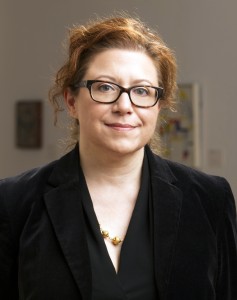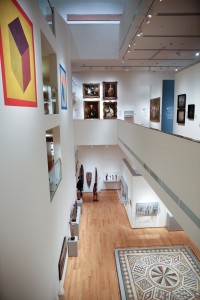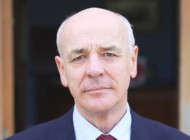
Dr Lisa Fischman was appointed as the Ruth Gordon Shapiro ‘37 director at the Davis Museum at Wellesley College in 2010. Trained as an Americanist, she has focused on investigating relationships among the fine arts, material culture, design and popular culture, and locates her interest “among creative spheres often presumed not to intersect.” In her role as chief curator at the Davis, Fischman specializes as a curator of contemporary art. The Davis Museum’s expansion and reinstallation of its permanent collection across three floors, telling the stories of collecting at Wellesley College, is now on view in the exhibition “The Davis ReDiscovered.”
What are some of the biggest surprises people will find in the galleries now?
Our reinstallation of the Davis Museum permanent collections galleries — “The Davis ReDiscovered” — features the museum’s most significant and finest objects, emphasizing the breadth and strength of our encyclopedic holdings. The new galleries now double the number of works on view, and they are chock-a-block with surprises. The new spaces themselves are an extraordinary pleasure, as is the gem-tone palette we selected to articulate the presentation of our various “collections.” The new configuration, designed by Rice+Lipka Architects, offers new views — both horizontal and vertical — that enhance our signature building, the first American commission built by Pritzker Prize-winning architect Rafael Moneo in 1993. And we have activated the building’s many interstitial spaces, installing artworks in spots designed to delight, surprise and pique curiosity.
The number of artworks on exhibit has doubled from about 300 to more than 620 now… Did you have many recent acquisitions or were these items that were stored and not on view?
The Davis has doubled the number of artworks now on view, and this includes works recently acquired as well as some long stored in our vaults — objects rarely, if ever, before seen. We are very active in collections growth; with the generous support of our Wellesley alumnae, and particularly our Friends of Art, the Davis’s holdings grow substantially every year through gifts. Our acquisitions program is also very energetic.
We are always on the lookout, and we are lucky to be relatively nimble in terms of the market. We cannot possibly compete with major museums or with top collectors who dominate the sphere, but we identify hidden gems for purchase nonetheless. And, none of us could have imagined how many surprises we would find in our holdings through this process, worthy by virtue of their quality and historical importance for inclusion in the reinstallation.
Can you share a bit of behind-the-scenes on how many works in the permanent collection were under consideration to be displayed, vs staying off view, and how the decisions were made as to which works went on view?
Nearly three years in the making, this momentous transformation of the Davis galleries represents a milestone of “rediscovery.” The process has involved Davis curators and collections staff, conservators, consulting scholars and specialists, student workers and summer interns, along with architecture, engineering and design firms.
I tasked the Davis curators — led by Dr Claire C. Whitner, following the departure of Dr Eve Straussman-Pflanzer for the Detroit Institute of Arts — with a full collections review, and asked that they focus particularly on paintings, sculptures and decorative objects, i.e., artworks that might be safely selected for long-term presentation, setting aside for later consideration the wealth of photographs, drawings and prints that must rotate due to light sensitivity. In consultation with Wellesley faculty colleagues and specialists around the country, they proposed a selection to emphasize the excellence and richness of our holdings, and to assemble new galleries as “collections” oriented geographically and chronologically.
What are some of the most interesting objects/discoveries come to light?
So many discoveries! Among them, we have been delighted to find hidden gems, objects long stored and forgotten that will see the public light of day for the first time. For example, take the extraordinary Willem Van De Velde the Elder “pen painting,” which is perhaps the best example of the Seventeenth Century Dutch artist’s work in a US museum. It was languishing in storage, obscured by a thick coat of deeply discolored varnish… which, as it turns out, preserved the surface in absolutely pristine condition. It is an exquisite maritime scene, full of nuanced detail, greatly rewarding to close looking.
Telling stories among the objects — local and global — seems to be unifying thread in the reinstalled galleries. Can you give us a few examples?
On one hand, we have the Antioch Mosaic; its story reveals a lot about changing museological attitudes toward the presentation of antiquities as well as demonstrates palpably the connections between contemporary interests and those of the ancient Mediterranean. The Roman mosaic arrived on campus in 1936, as a gift honoring Wellesley’s role in the archeological field dig at Antioch. Cut into five pieces for transport, it was repaired and installed as a floor in the Farnsworth Art Building; in 1958, it was reinstalled in the floor at the Jewett Arts Center, architect Paul Rudolph’s Brutalist building. At the Davis, it was installed in a niche on the museum’s top floor, where for 20-some years visitors could only appreciate it at a distance. Against the odds and after two years of planning, we brought it down; it took a specialist team of engineers, conservators, art handlers and curators to manage the project — really, it was a feat of fortitude and will.
On the other hand, our terrific “Blue and White Case” highlights global exchange and symbiosis through the movement of style and form under the auspices of blue and white ware. It includes Chinese, Delft and Safavid examples along with a most curious and interesting set of Chinese exportware cups rescued from a shipwreck, melded together as they were packed for transport.
—Andrea Valluzzo





